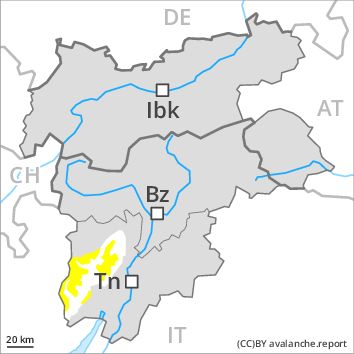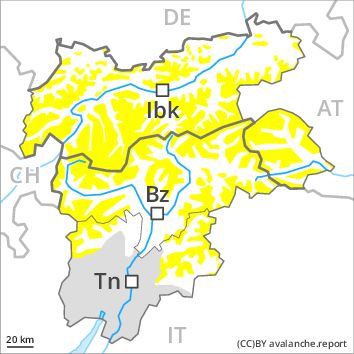Regions
Southern Adamello, Adamello - Presanella, Northern Brenta - Peller, Southern Brenta

Danger level
Danger Level 2 - Moderate above 2000m
No Rating above 2000m
Avalanche Problem
Wind-drifted snow above 2600m, N-NE-E-SE-S-SW-W-NW
Wet snow above 2000m, N-NE-E-SE-S-SW-W-NW

Regular avalanche bulletins with hazard maps will appear again from around the start of December, depending on the snow situation.
The Avalanche Warning Service currently has only a small amount of information that has been collected in the field.
The wind slabs of the last three days have bonded quite well with the old snowpack in particular on southeast to south to southwest facing aspects. The avalanche prone locations are to be found in particular adjacent to ridgelines and in gullies and bowls in all aspects. Mostly avalanches are medium-sized and can be released also by a single winter sport participant. The number and size of avalanche prone locations will increase with altitude.
The snowpack will become increasingly moist. In the regions exposed to heavier precipitation and on steep sunny slopes small to medium-sized wet snow slides and avalanches are to be expected as a consequence of warming during the day and solar radiation.
Snowpack
dp 10: springtime scenario
Over a wide area 10 to 40 cm of snow, and even more in some localities, has fallen in the last three days above approximately 2000 m. Individual weak layers exist in the old snowpack on steep shady slopes, especially above approximately 2800 m. At low altitude no snow is lying.
Tendency
Increase in danger of moist and wet avalanches as a consequence of warming during the day and solar radiation. High altitudes and the high Alpine regions: Wind slabs are to be evaluated critically.
Regions
Sexten Dolomites, Latemar, Southern Lagorai, Northern Lagorai, Allgäu Alps, Eastern Lechtal Alps - Ammergau Alps, Mieming Mountains, Karwendel Mountains, Brandenberg Alps, Wilder Kaiser Mountains - Waidring Alps, Western Lechtal Alps, Central Lechtal Alps, Grieskogel Mountains, Val Müstair Alps, Western Verwall Mountains, Langtaufers, Eastern Verwall Mountains, Schnals Ridge, Silvretta, Southern Stubai Alps, Samnaun Mountains, Southern Zillertal Alps and High Tauern, Northern Oetz and Stubai Alps, Saldurn-Mastaun Ridge, Western Tuxer Alps, Texel Mountains, Eastern Tuxer Alps, Sarntal Alps, Western Kitzbühel Alps, Western Pfunderer Mountains, Eastern Kitzbühel Alps, Glockturm Range, Maddalene, Eastern Pfunderer Mountains, Durreck Range, Weißkugel Range, Western Rieserferner Mountains, Gurgler Range, Western Deferegger Alps, Central Stubai Alps, Ortler Range, Northern Zillertal Alps, Ulten Valley, Venediger Range, Eastern Nonsberger Alps, Eastern Rieserferner Mountains, Northern Dolomites of Fiemme, Glockner Range, Gröden Dolomites, Primiero - Pale di S. Martino, Eastern Deferegger Alps, Prags Dolomites, Schober Mountains, Lienzer Dolomites, Western Nonsberg Alps, Fassa Valley, Sole, Pejo and Rabbi

Danger level
Danger Level 2 - Moderate above 2000m
No Rating above 2000m
Avalanche Problem
Wet snow above 2000m, N-NE-E-SE-S-SW-W-NW
Wind-drifted snow above 3000m, N-NE-NW

Regular avalanche bulletins with hazard maps will appear again from around the start of December, depending on the snow situation.
The Avalanche Warning Service currently has only a small amount of information that has been collected in the field. As a consequence of warming during the day and solar radiation more small and, in isolated cases, medium-sized moist and wet avalanches are possible. More frequent moist loose snow avalanches are to be expected. This applies above approximately 2000 m on extremely steep slopes. The prevalence of avalanche prone locations will increase with altitude. Caution is to be exercised in particular in the regions exposed to heavier precipitation.
High Alpine regions: In addition the fresh wind slabs especially adjacent to ridgelines are prone to triggering in some locations. In regions exposed to the foehn wind avalanche prone locations are more prevalent and exist in all aspects.
Snowpack
dp 10: springtime scenario
dp 6: cold, loose snow and wind
Some snow will fall in some regions. The wind will be moderate to strong. In very isolated cases wind slabs are lying on soft layers. This applies in particular on shady slopes above approximately 3000 m. Outgoing longwave radiation during the night will be reduced in some places. The snowpack will become increasingly moist. At low altitude no snow is lying. At intermediate altitudes hardly any snow is lying. The old snowpack will be in most cases stable.
Tendency
As a consequence of warming during the day and solar radiation there will be an increase in the danger of moist and wet avalanches.
Regions
Prealps, Cembra Valley, Bondone and Stivo, Vallarsa, Folgaria - Laverone, Ledro Valley, Paganella, Pine' - Mocheni Valley, Marzola - Valsugana

Danger level
Danger Level 1 - Low above 1900m
No Rating above 1900m
Avalanche Problem
Wet snow above 2300m above 1900m, N-NE-E-SE-S-SW-W-NW

Regular avalanche bulletins with hazard maps will appear again from around the start of December, depending on the snow situation.
The Avalanche Warning Service currently has only a small amount of information that has been collected in the field.
The snowpack remains in most cases moist. Moist and wet avalanches are possible even now.
Snowpack
dp 10: springtime scenario
The snowpack will be wet all the way through over a wide area. Outgoing longwave radiation during the night will be reduced. At low altitude no snow is lying.
Tendency
Slight increase in danger of moist and wet avalanches as a consequence of warming during the day and solar radiation.



